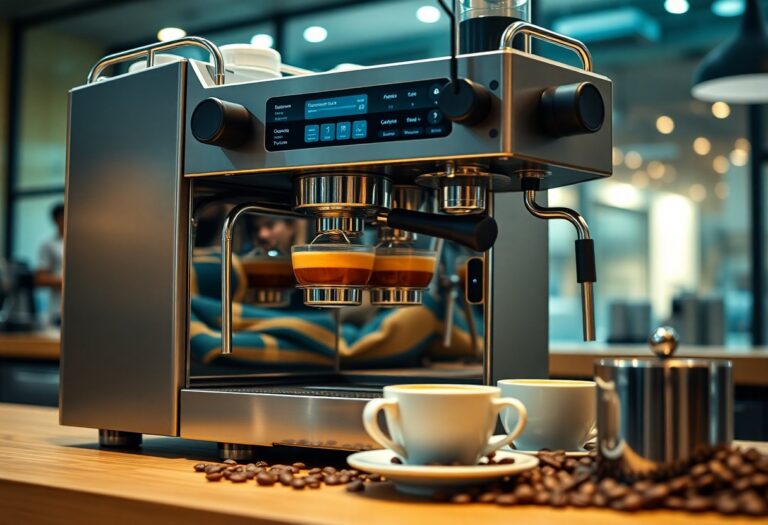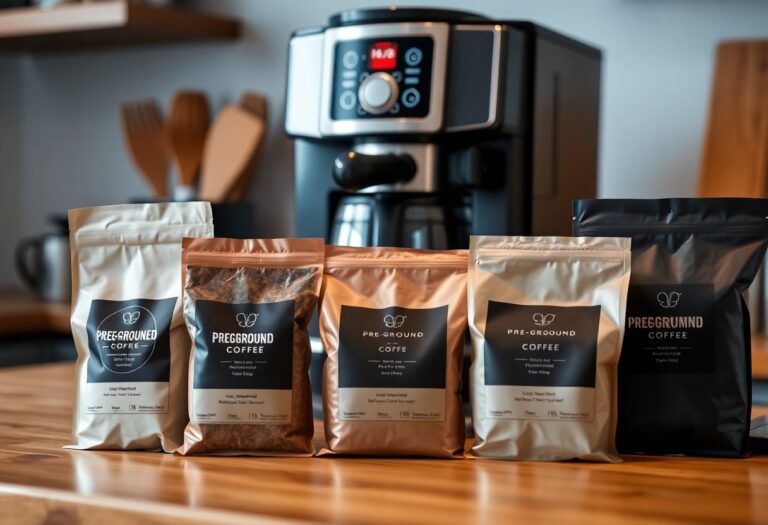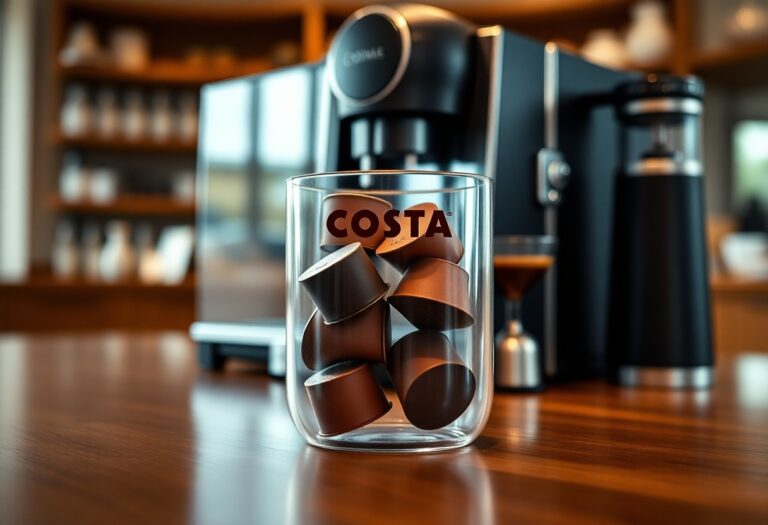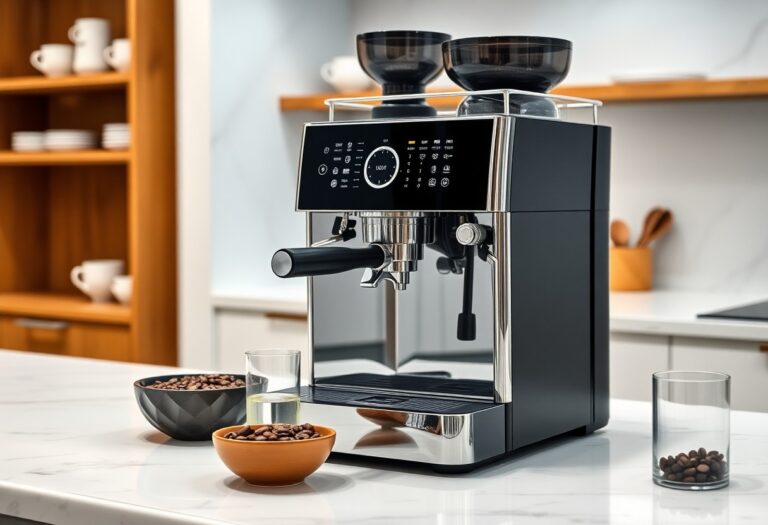What Do You Call a Coffee Machine – Common Names
Many of you may not realize that a coffee machine goes by several common names, each reflecting its unique features or brewing methods. From traditional drip coffee makers to modern espresso machines, understanding these terms can enhance your coffee experience. You might encounter a French press, a single-serve pod system, or even an automatic espresso machine, each offering distinct advantages and flavors. In this article, we will explore the various names for coffee machines, ensuring you know exactly what to call your favorite brewing device.

Key Takeaways:
- Coffee machines are commonly referred to as coffee makers, highlighting their primary function.
- Terms like espresso machine and drip coffee maker indicate specific types of coffee preparation methods.
- The term java machine is a more casual or slang-based name for coffee machines, reflecting a fun aspect of coffee culture.
- Some people may use the brand name, such as Keurig or Nespresso, interchangeably with coffee machine, showing brand influence.
- In different regions, variations such as coffee pot or coffee brewer may be used, illustrating local preferences in terminology.
The Lexicon of Coffee Machines: A Breakdown of Terminology
Understanding the terminology surrounding coffee machines can enhance your brewing experience. From the automatic drip coffee maker to espresso machines, each type has its own set of features and operation methods. Explore a comprehensive list of these devices and their characteristics in the Ten Types of Coffee Makers: A Full Guide. Knowing the right terms can help you make informed choices according to your preferences.
Common Terms for Coffee Makers
Coffee makers come with specific jargon that can sometimes be confusing. For example, a “drip coffee maker” refers to the machine that brews coffee by dripping hot water onto coffee grounds. An “espresso machine,” on the other hand, uses pressure to extract concentrated coffee. Understanding these terms can empower you when navigating coffee equipment and brewing methods, ensuring you select the best tools for your daily brewing ritual.
Regional Variations in Coffee Machine Names
Names for coffee machines can vary significantly across different regions. In the U.S., people may refer to standard drip machines simply as “coffee pots,” while in parts of Italy, an espresso maker is commonly known as a “moka pot.” These regional differences reflect not only cultural preferences but also brewing habits, showcasing a unique relationship to coffee across the globe. Your preferred terminology might even indicate the style of coffee you enjoy most; whether that’s a classic cup or a bold espresso.
Such names are deeply embedded in local coffee culture and help communicate what someone might be seeking when ordering. For instance, a “cafetière” is widely accepted in France as a French press, while Australians might ask for a “plunger” when referring to the same device. The unique nomenclature underscores how locals engage with coffee rituals and reflects the diverse preferences that exist worldwide.
The Evolution of Coffee Machine Nomenclature
Historical Context and Development
From the early days of brewing, the terms associated with coffee machines have evolved significantly. Initially simple devices like the percolator and drip coffee makers dominated the landscape, with each invention sparking new terminology to describe its function. Over time, terms have adapted and expanded as technology progressed, leading us to sophisticated espresso machines and single-serve pod systems. The transition in naming reflects not just technological advancement but also the growing coffee culture itself.
Influences from Coffee Culture on Naming Trends
The rich traditions and diverse practices surrounding coffee significantly shape how you refer to coffee machines. With a surge in coffee expertise and appreciation, terms like “barista” and “craft brewing” continue to influence the language. Notably, the rise of specialty coffee shops has popularized terms related to espresso-making, leading to the common use of “coffee maker” when referring to anything capable of brewing.
As coffee culture gained momentum in the late 20th and early 21st centuries, naming conventions began to reflect a deeper understanding of brewing nuances. For instance, espresso machines became known not just for their function but for their art, with terms like “manual lever” and “semi-automatic” emerging to differentiate levels of control and skill. You might notice that as specialty coffee shops pop up worldwide, their unique branding often includes playful terms for coffee machines, like “pour-over station” or “cold brew system.” This creativity underscores the evolution of language tied to the coffee experience, signifying a passion for quality brewing.
The Role of Brand and Reputation in Coffee Machine Terminology
The influence of brand and reputation in the coffee machine market is significant, shaping not only consumer preferences but also the terminology used. When specific brands become synonymous with particular machine types, this can dictate how consumers refer to coffee machines more broadly. As brands establish their identities and garner loyal followings, their influence extends into everyday conversations, leading to the use of brand names as interchangeable terms for equipment. This phenomenon illustrates how branding can define and sometimes limit the language surrounding a product category.
How Brands Shape Common Language
Your choice of coffee machine often reflects the brand’s reputation, and the language surrounding these machines evolves as brands become household names. For instance, terms like “Keurig” and “Nespresso” frequently replace generic terms like “single-serve brewer” in everyday discussions. This reflects a trend where specific brands lend linguistic weight to product categories, reinforcing their dominance in the market while shaping consumer perception and preferences.
Iconic Coffee Machines and Their Namesakes
Certain coffee machines have achieved iconic status, often becoming synonymous with innovative brewing methods or popular coffee culture. Brands like “Breville” and “Moka Pot” embody specific brewing styles, and their names often describe a type of machine or technique rather than the actual product itself. For many coffee enthusiasts, these names represent more than just equipment; they hint at an entire experience and lifestyle, making the terminology both meaningful and marketable.
For instance, the “Moka Pot,” originally developed by Alfonso Bialetti in the 1930s, has become a staple in many households worldwide, influencing how you brew espresso-like coffee at home. While it’s a specific type of stovetop coffee maker, you’re more likely to hear someone simply asking for a “Moka” instead of referring to it as a stovetop espresso maker. Similarly, the “French Press” has transcended its functional use to become a beloved part of coffee culture, leading to the widespread use of its name rather than describing it in terms of its brewing method. Such iconic machines not only identify themselves through their impressive legacy but also inspire a common vernacular that coffee lovers readily adopt.
Coffee Machine Classification: More Than Just Labels
Coffee machines come with a variety of classifications that extend beyond mere terminology. Understanding these labels can help you navigate the diverse world of coffee brewers, ensuring you choose the right type for your specific preferences and brewing style. Whether you prefer espresso, drip, or single-serve, each machine serves its purpose while offering unique features tailored to your coffee experience. Furthermore, the classification can guide you in finding machines that match your workflow, taste, and lifestyle for that perfect cup of joe.
The Functionality Behind Different Names
Different names for coffee machines often correspond to their functionality and brewing methods. For instance, an “espresso machine” uses pressure to extract concentrated shots, whereas a “drip coffee maker” utilizes gravity for a milder brew. Understanding these distinctions allows you to select a machine that aligns with your taste preferences and desired level of complexity in the coffee-making process. It’s not just about the label—it’s how each machine delivers your morning ritual.
How Marketing Influences Perceptions and Terminology
Marketing significantly shapes how you perceive coffee machines and their corresponding terminology. Companies frequently employ buzzwords and trendy names to distinguish their products in a saturated market, influencing your choices and perceptions of quality. Terms like “artisanal” or “barista-grade” may evoke certain expectations, leading you to associate these machines with superior performance, even if the actual differences are subtle. This strategic naming often drives consumer behavior and preferences.
A classic example is the rise of “single-serve coffee makers,” which have been promoted with phrases like “convenient” and “gourmet,” appealing to your desire for ease and luxury. Marketing campaigns can create an emotional connection to a machine, making you feel like you’re investing in a premium product. This not only affects how you perceive the functionality but also the price point you’re willing to pay. As a result, understanding these marketing strategies can empower you to make informed decisions rather than being swayed by catchy names alone.

The Fun Side of Coffee Machine Names: Quirky Monikers and Nicknames
Regarding coffee machines, creativity shines through in the quirky monikers and nicknames that aficionados often use. Terms like “bean juice maker” or “caffeine generator” add a dash of personality to the often serious world of brewing. These playful names not only reflect your enthusiasm for coffee but also foster a sense of community among fellow coffee lovers, who might share your affection for their trusty brewing companions.
Creative and Informal Names Used by Coffee Enthusiasts
Creative names like “Java Jiggler” or “Brew Buddy” exemplify the informal language that coffee enthusiasts embrace. You might find that such nicknames often arise from personal experiences or stories surrounding the coffee machine’s use. Whether it’s a late-night brew session or a particularly memorable cup of coffee shared with friends, these charming titles serve as endearing reminders of the joy coffee brings to your daily routine.
The Impact of Online Communities on Naming Trends
Online communities play a significant role in shaping naming trends for coffee machines. Platforms like Reddit and specialized coffee forums allow enthusiasts to share their unique experiences and creative expressions in real-time. As members engage in discussions about their favorite brews, you can observe how certain nicknames gain popularity, often spreading virally across different social media platforms.
For instance, a quirky name shared on a popular coffee subreddit could quickly capture the imagination of countless users, leading to a surge in its popularity. Community members might start using it with their coffee machines, leading to a collective sense of identity. The trend often evolves as members add their personal twists, creating a living lexicon of coffee machine names that mirrors the vibrant culture surrounding coffee. Embracing these informal titles can enhance your connection with the coffee community while celebrating the journey every cup represents.
Final Words
Hence, understanding the various names for a coffee machine can enhance your conversations about coffee equipment. Whether you call it a coffee maker, espresso machine, or percolator, knowing these terms ensures you can express your preferences and needs to others effectively. As you explore the world of coffee, you’ll find that each term often reflects a unique method of brewing that suits your individual taste. Embrace these names as part of your coffee journey and enjoy crafting the perfect brew.
FAQ
Q: What are the most common names for coffee machines?
A: Coffee machines are commonly referred to by several names, including coffee makers, espresso machines, drip coffee makers, single-serve coffee brewers, and percolators. Each type serves a different purpose and uses various brewing methods to prepare coffee.
Q: Is there a difference between a coffee maker and an espresso machine?
A: Yes, there is a significant difference. A coffee maker typically brews coffee using a drip method, producing a lighter and larger quantity of coffee. An espresso machine, on the other hand, uses high pressure to force hot water through finely-ground coffee, resulting in a concentrated shot of espresso with a rich flavor and crema.
Q: What is a single-serve coffee brewer?
A: A single-serve coffee brewer, often known by brand names like Keurig or Nespresso, is designed to brew one cup of coffee at a time from pre-packaged coffee pods or capsules. This type of machine is popular for its convenience and speed, allowing users to enjoy a fresh cup without the hassle of brewing a full pot.
Q: What is a percolator and how does it work?
A: A percolator is a type of coffee maker that brews coffee by cycling boiling water through coffee grounds multiple times. The water is heated in a lower chamber, then forced up a tube to the coffee grounds in an upper chamber. As the brewed coffee seeps back down, the process continues until the desired strength is achieved.
Q: Are there other specific types of coffee machines and what are they called?
A: Yes, there are several other types of coffee machines including French press (also known as a press pot), cold brew coffee makers, moka pots (stovetop espresso makers), and siphon coffee makers. Each of these types employs unique methods of brewing coffee, catering to different preferences and tastes.







